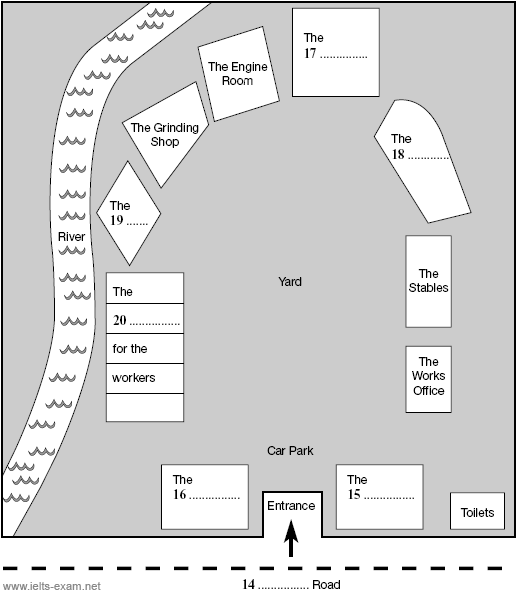IELTS Listening 6 - Section 2
Listening Tips
- You only have a few seconds to read each section before you listen, but you will have ten minutes at the end to put your answers on the answer sheet.
- You only hear each listening text once. Read the questions before you start listening and look for key words and phrases.
- The questions are always in the same order as you hear the answers.
- The time between answers in the recording is short, so dont get left behind while trying to think of an answer.
- If you miss something, have a guess based on key words and phrases you have heard. Then move on to the next question.
Section 2: You will hear a speech by an official about Riverside Industrial Village. First you have some time to look at Questions 11-20.
Now Listen carefully and answer Questions 11 to 20:
Questions 11-13
Complete the sentences below.
Write NO MORE THAN THREE WORDS AND/OR A NUMBER for each answer.
RIVERSIDE INDUSTRIAL VILLAGE
11Riverside Village was a good place to start an industry because it had water, raw materials and fuels such as and .
12The metal industry was established at Riverside Village by who lived in the area.
13There were over water-powered mills in the area in the eighteenth century.
Questions 14-20
Complete the plan below.
Write NO MORE THAN TWO WORDS for each answer.

14 Road
15The
16The
17The
18The
19The
20The for the workers
Good afternoon everybody and welcome to Riverside Industrial Village. To start your visit I'm just going to give you a brief account of the history of the museum before letting you roam about on your own. I won't keep you long. OK?
Now, from where we're standing you've got a good view of the river over there. And it was because of this fast-flowing water that this site was a natural place for manufacturing works. The water and the availability of raw materials in the area, like minerals and iron ore, and also the abundance of local fuels, like coal and firewood, all made this site suitable for industry from a very early time.
Water was the main source of power for the early industries and some of the water wheels were first established in the twelfth century, would you believe? At that time, local craftsmen first built an iron forge just behind the village here, on the bend in the river. By the seventeenth and eighteenth centuries the region's rivers supported more than a hundred and sixty water mills - and many of these continued to operate well into the nineteenth century. But then the steam engine was invented and then the railways came and the centres of industry were able to move away from the rivers and the countryside and into the towns. So, industrial villages like this one became very rare.
So that's the history for you. If you'd like any more information, you can ask me some questions, or you can read further in our excellent guide book.
Now I'm going to give you a plan of the site and I'd just like to point out where everything is and then you can take a look at everything for yourself.
I've already pointed out the river, which is on the left. And of course, running along the bottom is Woodside Road, got it? OK. Now we're standing at the entrance, see it at the bottom, and immediately to our right is the Ticket Office. You won't need that because you've got your group booking, but just past it are the toilets - always good to know where they are. In (rant of us is the car park, as you can see, and to the left, by the entry gate is the Gift Shop. That's where you can get copies of the guide, like this one here.
Now, beyond the car park all the buildings are arranged in a half circle with a yard in the middle. The big, stone building at the top is the main Workshop. That's where the furnace is and where all the metal was smelted and the tools were cast, as you'll be able to see. Now, in the top right-hand corner, that building with bigger windows is the Showroom, where samples of all the tools that were made through the ages are on display. In the top left corner is the Grinding Shop, where the tools were sharpened and finished. And on one side of that you can see the Engine Room and on the other is the Cafe, which isn't an antique, you'll be pleased to know, though they do serve very nice old-fashioned teas.
The row of buildings you can see on the left are the cottages. These were built for the workers towards the end of the eighteenth century and they're still furnished from that period so you can get a good idea of ordinary people's living conditions. Across the yard from them, you can see the stables where the horses were kept for transporting the products. And the separate building in front of them is the Works Office and that still has some of the old accounts on display.
Right, if anyone wants a guided tour then I'm starting at the Engine Room. If you'd like to come along, this way please, ladies and gentlemen.